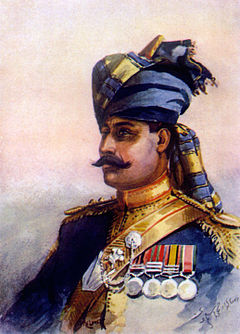
4th Horse (Hodson's Horse) is a part of the Armoured Corps of the Indian Army, which had its beginnings as an irregular cavalry regiment during the time of the Indian Rebellion of 1857.
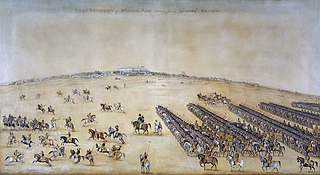
The 1st Horse (Skinner's Horse) is a regiment of the Armoured Corps of the Indian Army. It traces its origins as a cavalry regiment from the times of the East India Company, followed by its service in the British Indian Army and finally, after independence as the fourth oldest and one of the senior cavalry regiments of the Armoured Corps of the Indian Army.
The 6th King Edward's Own Cavalry was a cavalry regiment in the Bengal Army (1842–1895) and the British Indian Army (1895–1921) until it was amalgamated with the 7th Hariana Lancers to form the 18th King Edward's Own Cavalry.
The 5th Cavalry was a cavalry regiment of the Bengal Army (1841-1895) and the British Indian Army (1895-1921) until it was amalgamated with the 8th Lancers to form the 3rd Cavalry.

The 7th Hariana Lancers was a cavalry regiment in the British Indian Army. It was raised in Meerut and Cawnpore in 1846 by Captain J. Liptrott as a regiment of Bengal irregular cavalry. The regiment was amalgamated with the 6th King Edward's Own Cavalry to form the 18th King Edward's Own Cavalry.
The 8th Lancers was a cavalry regiment of the Bengal Army (1846-1895) and the British Indian Army until 1921 when it was amalgamated 5th Cavalry regiment to form the 3rd Cavalry regiment.

The 14th Murray's Jat Lancers, also sometimes known as the Murray's Jat Horse, was a cavalry regiment of the British Indian Army. In 1921 it was renamed as 20th Lancers, and after Partition of India in 1947 it eventually became 20 Lancers (India) as an armoured regiment of the Indian Army. Its muslim soldiers were retained in the regiment which is now known as the 20th Lancers (Pakistan).
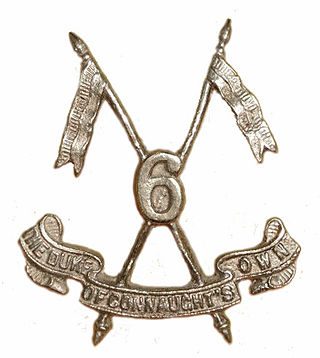
The 6th Lancers is an armoured regiment of the Pakistan Army. Previously, it was known as the 6th Duke of Connaught's Own Lancers (Watson's Horse), and was a regular cavalry regiment in the British Indian Army. It was formed in 1921 by amalgamation of the 13th Duke of Connaught's Lancers (Watson's Horse) and the 16th Cavalry. The regiment and its predecessors have seen active service on the North West Frontier, in Egypt during 1882, in China during the Boxer Rebellion, the two World Wars and the Indo-Pakistani War of 1965. On the Partition of India in 1947, the regiment was allotted to the Pakistan Army, where it remains in service today.

The 3rd Cavalry Regiment is a cavalry regiment of the Indian Army formed from the 5th and 8th Cavalry regiments in 1922.

The Deccan Horse or 9 Horse is one of the oldest and most decorated armoured regiments of the Indian Army. The Royal Deccan Horse , which was a regular cavalry regiment of the British Indian Army was formed from the amalgamation of two regiments after World War I. They saw service from the Mutiny of 1857 up to and including World War II.
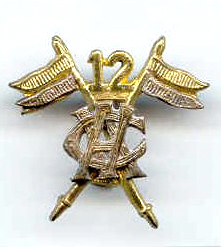
The 12th Cavalry Sam Browne's Cavalry (Frontier Force) is an armoured regiment of Pakistan Army. It was formed in the British Indian army in 1922 by the amalgamation of 22nd Sam Browne's Cavalry (Frontier Force) and 25th Cavalry (Frontier Force).

The 15th Lancers (Baloch) is an armoured regiment of the Pakistan Army. It was formed in 1922 by the amalgamation of the 17th Cavalry and the 37th Lancers (Baluch Horse).
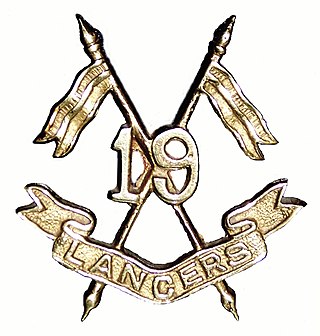
The 19th Lancers is an armoured regiment of the Pakistan Army. Before 1956, it was known as 19th King George V's Own Lancers, which was a regular cavalry regiment of the British Indian Army. It was formed in 1922, by the amalgamation of 18th King George's Own Lancers and 19th Lancers (Fane's Horse). On Partition of India in 1947, the regiment was allotted to Pakistan.

The 20th Lancers is an armoured regiment in the Armoured Corps of the Pakistan Army. It is considered to be the successor of the old 20th Lancers of the British Indian Army. As part of a reorganization of the British Indian Army, the original 20th Lancers was formed in 1922 by the amalgamation of the 14th Murray's Jat Lancers and the 15th Lancers.
The 18th Cavalry is a cavalry regiment of the armoured corps of the Indian Army. The regiment was created in 1921, as the 18th King Edward's Own Cavalry of the British Indian Army, through the amalgamation of the 7th Hariana Lancers and 6th King Edward's Own Cavalry.
The 1st (Risalpur) Cavalry Brigade was a cavalry brigade of the British Indian Army formed in 1906 as a result of the Kitchener Reforms. It remained in India during the First World War but took an active part in the Third Anglo-Afghan War in 1919.

The 13th Lancers is an armoured regiment of Pakistan Army. It was formed in 1923 as 13th Duke of Connaught's Own Lancers by the amalgamation of 31st Duke of Connaught's Own Lancers and 32nd Lancers. On Partition of India in 1947, the regiment was allotted to Pakistan.
The 20th Lancers was a regiment of the British Indian Army.

